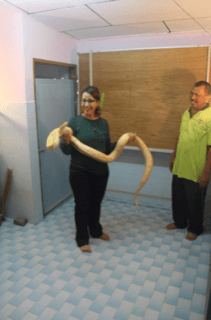Let’s synergize our efforts to save lives
My name is Naoual Oukkache.
I am the head of the Venoms and Toxins laboratory at the Institut Pasteur of Morocco. My team’s activity revolves around the characterization of snake and scorpion venoms to a therapeutic end, whether it be for drug discovery or for the conception of antivenoms.
Currently, we are developing a new type of antivenom against the molecules responsible for mortality. Our goal is to improve current treatments of snakebites and scorpion stings in order to reduce the lethality and the number of disfigurements that happen every year.
Ophidan envenomation is the first cause of animal poisoning and death worldwide. Statistically, snake envenomation entails more than 5 million people bitten yearly out of whom 100,000 die and more than 300,000 are permanently disabled or disfigured. However, many snakebites remain unreported.

Naoual working with her colleagues
In Africa, snake bites are a serious problem: every year, tens of thousands of snakebite victims in Africa die or lose their limbs.
The snake bite prevention is possible when antivenom is considered as a global treatment and not only as an antidote to the lethal effects of venom. Unfortunately, only about 20,000 vials of antivenoms are produced annually, and most of the antivenoms available on the market don’t always work well and aren’t specific to neutralize different snake venoms.
Actually, Africa is facing a growing snakebite crisis (high mortality) and there is a serious shortage of antivenom. This situation is complicated by multiple reasons mainly lack of information, eg epidemiological, species, venom, symptoms, etc.
The detailed knowledge of the geographical repartition of the snake species that are medically important, intraspecific variations in venom composition, the clinical and toxicological data, physiopathological symptoms, toxin composition of venoms and cross reactions will contribute to in-depth understanding on the pathogenesis of envenomation mechanisms and serve the development of innovative antivenoms.
How best do we go about solving the current snakebite crisis?
How can we best do this so that antivenom reaches more people?
To confront this neglected health problem, it is very important to develop an international network associating different expertise in the field of ophidian envenomations including herpetologists, anthropologists, toxinologists, epidemiologists, public health authorities and clinicians. This network will bring together expertise in various areas related to the field.
We aim to implement a dynamic that allows us to achieve an overall project with an international network around the production of antivenoms, quality assurance and evaluation through clinical and biomedical research.
In order to investigate the immunoreactivity, the antivenomics approach will be used for the identification of venom proteins bearing epitopes recognized by an antivenom using proteomic techniques. This is expected to facilitate the preclinical assessment of antivenom efficacy, leading to a new generation of antivenoms that are clinically more effective.
Let’s synergize our efforts to save lives.
This blog was written as part of the Women Champions of Snakebite campaign, supported by the Lillian Lincoln Foundation, Health Action International and Global Snakebite Initiative.
This blog is licensed under a Creative Commons Attribution-NonCommercial 4.0 International Licence. View a copy of this licence at https://creativecommons.org/licenses/by-nc/4.0/
